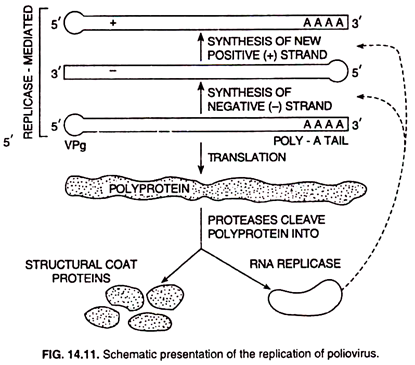In this article we will discuss about:- 1. Meaning of Poliovirus 2. Morphology of Poliovirus 3. Replication 4. Cultivation.
Meaning of Poliovirus:
Poliovirus is a member of the enterovirus subgroup, family Picornaviridae. Picornaviruses are small, ether- insensitive viruses with an RNA genome. There are three poliovirus serotypes: serotype 1, 2, and 3. Serotype 1 is the common epidemic type, serotype 2 is usually associated with endemic infections, and serotype 3 occasionally causes epidemics.
The poliovirus has affinity for nervous tissue and narrow host range. Only man and some primates such as cynomolgous and rhesus monkeys are susceptible.
Morphology of Poliovirus:
The poliovirus virion possesses icosahedral structure with 60 morphological units per virion, each unit consisting of four distinct viral proteins (VP1-VP4). VP1 faces outside and carries the major antigenic site for combination with serotype specific neutralizing antibodies.
The genome of poliovirus is a linear positive sense, single-stranded RNA molecule consisting of 7440 bases in length. At the 5′ terminus of the viral RNA, is a protein called VPg protein that is attached covalently to the RNA. At the 3 terminus of RNA is C poly-A tail.
Replication of Poliovirus:
The single-stranded positive sense (+) RNA acts as messenger RNA (mRNA). The 5′ end of RNA has a long sequence that can fold into several stem-loops. The VPg protein and the stem-loops mimic the cap-binding complex, and these permit binding of the poliovirus mRNA to the host cell ribosome. The virus RNA codes for all the proteins of the virus into one large protein molecule called poly-protein.
This protein is cleaved into the individual proteins including the structural coat proteins and the RNA replicase that bring about replication of the poliovirus RNA. The assembly of intact poliovirus from coat protein molecules and RNA then follows. The whole poliovirus replication process, an overview of which is illustrated in Fig. 14.11, takes place in cell cytoplasm.
Cultivation of Poliovirus:
The poliovirus grows readily in tissue cultures of primate origin. Primary monkey kidney cultures are used for diagnosis and vaccine production. The infected cells round up and become retractile and pyknotic. Eosinophilic intra-nuclear inclusion bodies may be observed in stained preparations. Well formed plaques develop in infected monolayers with agar overplay.
